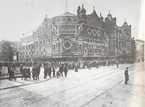Grand Opera House
Frank Matcham
Grand Opera House | |
| Auf der Karte zeigen | http://www.goh.co.uk/ |
Wichtige Ereignisse
Menschen
Geschichte
The Grand Opera House and its marvellous resurrection are the raison d'etre of this book. The three-bay centrepiece of the facade, in brick and cast stone, with three circular windows under a wide pedimental gable, has i something in common with the near-contemporary, though more modest, Opera House. Wakefield. The flanking onion-domed minarets, however, are a foretaste of the interior, and are the only surviving oriental motif on the exterior of a Matcham theatre. The original Empire Palace in Edinburgh (1892), the Empire Palace, Leeds (1897), and the Palace, Leicester (1901) are others which sported external oriental trappings to a greater or lesser extent, and which have now been demolished.
Matcham took advantage of the relatively open corner site to create a three-dimensional build-up from the low corners towards the higher gabled centrepiece. Open-arched balustraded parapets across the canted corners conceal roof pitches which rise up to the rear walls of the auditorium. These have decorative stuccowork surrounding oval windows. The new conservatory-like extension to the first-floor bar is entirely in keeping with the imaginative free-style manner of Matcham's exterior and is reminiscent of the splendid iron and glass projection on the facade of the Theatre Royal, Portsmouth.
The tastefully restrained foyers and staircases lead to the magnificently restored auditorium, which shows Matcham at his best. It is by far the most notable surviving example of his oriental manner, or, indeed, of any theatre in the United Kingdom decorated in this style. At this stage of his career, and up untii c. 1903 he was capable of producing designs of a theatrical opulence, yet still maintaining a lightness often absent in the heavier Baroque manner of his later work. At Belfast the sinuous curves of the balconies, the superimposed boxes crowned by onion domes, the arches under the richly-framed painted panels of the ceiling, and the overall intricacy of the Indian-style plasterwork, combine to produce exactly the right atmosphere.
In: WALKER, Brian Mercer. Frank Matcham: theatre architect. Belfast: Blackstaff Press, c1980, xii, 178 p. ISBN 08-564-0231-1. p. 128 - 129
Autor: Brian Mercer Walker
Brian Mercer Walker:
Weitere Informationen
Keine Information vorhanden
Information hinzufügen














